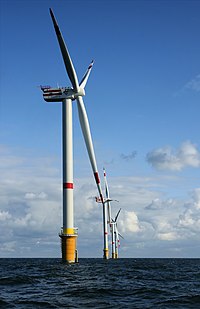
Photo from wikipedia
Prediction of icing on wind turbine blades is crucial, particularly in high-latitude areas where ice accumulation is a frequent occurrence. Traditional centralized data-driven approaches for predicting blade icing have demonstrated… Click to show full abstract
Prediction of icing on wind turbine blades is crucial, particularly in high-latitude areas where ice accumulation is a frequent occurrence. Traditional centralized data-driven approaches for predicting blade icing have demonstrated promising performance, but they require a large amount of storage and computational resources and may also raise concerns about data privacy. Federated learning (FL) presents a potential solution to address these issues. These challenges include redundant features in the collected data, a highly imbalanced data distribution between normal and icing samples, and slow model convergence during FL training. To tackle these challenges, we proposed a novel FL model called FL-based model for blade icing prediction (FedBIP). FedBIP employs a feature selection approach enhanced with human knowledge to select relevant features, a segmentation-based oversampling method to alleviate class imbalance, and a new aggregation method that takes into account data size, timestamps, and offsets of each participating client. In addition, knowledge distillation (KD) is employed in the local model training to accelerate model convergence and speed up the overall training process. The results of comprehensive experiments demonstrate that FedBIP outperforms the state-of-the-art FL methods, aggregation methods, and feature extractors. Ablation and sensitivity analysis were also conducted to validate the importance of each component and key parameters in FedBIP.
Journal Title: IEEE Transactions on Instrumentation and Measurement
Year Published: 2023
Link to full text (if available)
Share on Social Media: Sign Up to like & get
recommendations!